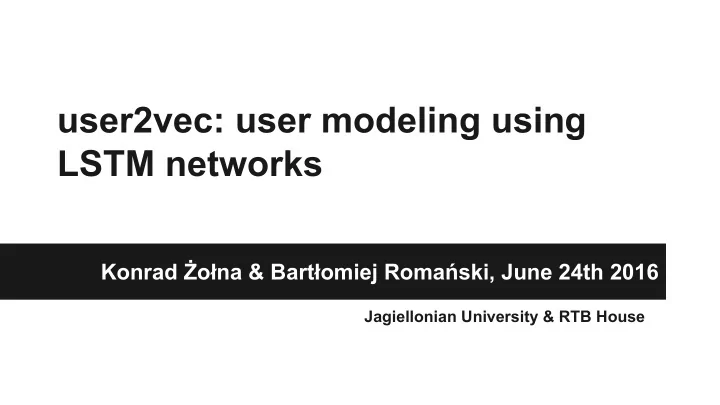

user2vec: user modeling using LSTM networks Konrad Żołna & Bartłomiej Romański, June 24th 2016 Jagiellonian University & RTB House
User modeling User modeling describes the process of building up and modifying a state (internal representation) of the user. The main goal of user modeling is customization and adaptation of systems to the user's specific needs .
Real-time bidding Real-time bidding (RTB) is an online advertising auction-based model where the advertiser valuates every single impression opportunity. A bid value is usually based on a predicted impression value evaluated using low level features such as the history of the user’s activity on the advertiser’s webpage or the size of the ad slot .
User history as an input? Typically the history of the user is projected into a fixed number of manually-crafted features which are believed to help in prediction. These features are usually extracted using a baseline feature extraction methods like counting or binning .
Manually-crafted features Manual crafting requires a human expert whose work is laborious and expensive. Usefulness of features may depend on the advertiser, so a human has to revise them frequently and reexplore for every new advertiser. Since features are snapshot at the time of the impression, models don’t learn from events which follow the last impression of the user and ignores the data for users who have never seen any impressions. Data is lost.
Sequential input Our LSTM model is fed sequentially with every event originating from the user’s activity on the advertiser’s website. Input to a single step is represented as a vector of seven real numbers: one-hot encoded type of the event and normalized time to the previous event .
Sequential input (example) In the first session a user visited home page , viewed details of three products with browsing two listings between. The second session (3 days after the first one) is started by browsing product details and finalizes with a conversion . The figure also shows how these actions are encoded to be interpretable by the LSTM model: one-hot encoded event’s type first and normalized time to the previous event last.
Targets of our LSTM model A single input for the user is the sequence of all the events and targets are answers to a fixed list of a few questions asked at the time of every event. a. Will the user come back in less than 30 days after this session ends? b. What is the type of the next event ? c. Will this session end in 20 secs / 2 mins / 20 mins / more than 20 mins? d. Will the next session start in 16 hrs / more than 16 hrs / never? e. Will the next conversion be in this session / after this session / never? f. Will the user convert in the next 30 days?
Our LSTM model
Memory cells of LSTM State of every LSTM model is stored in two fixed size vectors of real numbers called the memory cells and the last output . Since our LSTM model is trained to predict user’s behavior, elements of these vectors are the natural candidates for the user-dependent features (they depict a user’s state ). They can be extended by the resulting predictions (answers to the questions).
user2vec Learned on historic data LSTM is set up and constantly monitors all events performed on the advertiser’s website. At any time one can ask the LSTM about it’s state for the particular user which can be understood as the user’s state . This procedure is called user2vec and obtained features can be used further by more specialist models like CR model.
CR model comparison 1/2 Two CR models were considered each one in two versions : a core version (only core features), an extended version (with additional user2vec features). Considered models are: Poisson regression ( PR, PR + LSTM ), Deep neural net ( DNN, DNN + LSTM ).
CR model comparison 2/2
Current directions The LSTM can be fed with more detailed descriptions of the event . For example, for a viewed product, the LSTM can also get the identifier of the product . It may result in two benefits: a. the projection is more sophisticated and accurate , b. possibility of performing useful hallucination .
End of presentation Thank you for your attention.
Sequential data
Recurrent Neural Networks
Long short-term memory
LSTM, step by step
End of presentation Part of LSTM is taken from the blog of Andrej Karpathy (The Unreasonable Effectiveness of Recurrent Neural Networks) and the blog of Christopher Olah (Understanding LSTM Networks). Thank you for your attention.
Recommend
More recommend